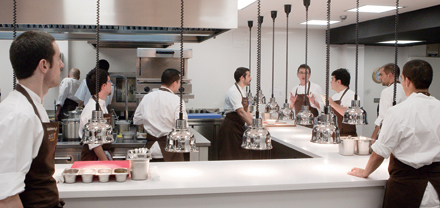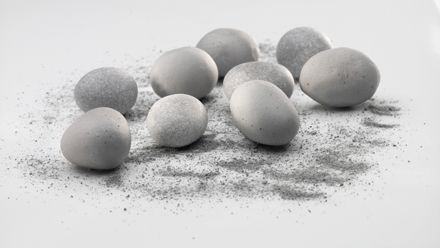Mugaritz – back from the brink
Last year, one of Spain's most celebrated restaurants, the two-Michelin-starred Mugaritz, was gutted by a fire that destroyed the entire kitchen. Luciana Bianchi talks to chef-patron Andoni Luis Aduriz about the rebuild
Andoni Luis Aduriz is an unconventional chef, who is considered a rising star in Spanish gastronomy and is celebrated for deconstructing food and putting it back together in surprising ways.
His previous employers include Juan Mari Arzak and Martin Berasategui, and he was a protégé of Ferran Adrià at El Bulli. He opened his restaurant, Mugaritz, 12 years ago, and since then has helped to shape the new era of haute cuisine.
Aduriz's cooking is full of poetry, philosophical reflection and boasts a highly technical and scientific approach. A deep love for the Basque country and its produce is also evident in his cuisine.
Mugaritz is situated on a farm, surrounded by ancient trees, organic gardens and wild flowers. The culinary epicentre of San Sebastian is just eight miles away.
Last year, a fire broke out at the restaurant, which destroyed the kitchen. After four months of courage, hard work and support from friends, Aduriz reopened the restaurant, ready to begin a new phase.
A short-circuit in the kitchen in the middle of the night caused the fire, which spread quickly through the whole building.
Did you consider closing the restaurant?
Immediately after the fire we found ourselves in a deep hole. The restaurant is our livelihood, and is a tough business, the reason why we never managed to save money. We were without the restaurant; we had 40 employees to pay, and bills to be paid amounting to thousands of Euros. We were on the verge of closing.
In the event, we shut for four months. We started with the reconstruction three weeks after the fire; until then, the investigations into its cause were ongoing. The insurance company worked very quickly to resolve everything, but there were many expenses and overheads to be covered on a daily basis. We had to survive for this period without a job and take care of our people. But we were lucky to count on the help of many friends.
Is there anything in particular that gave you the strength to rebuild the restaurant? We didn't have a plan B. There was only one way to solve the problem - to pull ourselves together and reopen as soon as possible. I have often asked for the support and strength of my team throughout the past few years, but at this difficult moment, it was particularly important that I led them with a big project in our hands.
What did you do while Mugaritz was closed?
We followed each step of the reconstruction, and each one of us had a task to perform. There were many side projects involving research and cultural projects. For example, we did a project with a theatre company called La Fura Dels Baus before their world tour. We didn't stop for a minute.
Its outstanding features are the large spaces between the cooking stations, the bright, clean colours and the ergonomic components. The lighting is unusual because it is based in a large window and enhances the natural light.
The equipment we have in the kitchen is pretty much the same as before the fire, with the difference that now we are seeking precision in cooking temperatures and humidity control. All the technology, from induction burners to heat lamps, has been provided by our partner De Dietrich. It has been adapted to our needs with great attention to detail.
The new design and setting of the kitchen allows us now to work from the beginning to the end [of service] without interrupting the ‘heat chain' that begins on the stove and finishes on the plate. It sounds obvious, but it is a very complex issue in a kitchen producing 600 dishes each day for lunch and dinner.
At the entrance to the kitchen there is an image of a tree and Japanese writing - what is the story behind it? The tree is engraved on the silestone wall and is accompanied by the names of all the Japanese chefs that helped us to rebuild the kitchen. The sentence on the roots of the tree in the Japanese and Basque languages means: "Shoots of the tree of friendship".
Do you have any plans for expansion? We have received many offers from all over the world, but so far we have decided to focus only on Mugaritz and to build a strong team here. But nobody knows what the future holds.
What makes a great dining experience? This will depend on what people expect and the context of their visit. In our case, we don't offer food, but experiences. Our dining room is not just a place where people go to eat, but where all senses are stimulated. We want people to enjoy, discover and learn new things, and also discover themselves. For me, the meaning of good food is culture, knowledge, pleasure, responsibility and innovation.
TOASTED AUBERGINE DUST
Ingredients 1.2g Dentie powder - a Japanese product comprised of charred aubergine and sea salt, which is used as toothpaste and can be bought in certain speciality stores
OR one aubergine and unrefined sea salt
Method Wrap the top part of the aubergine, including the calyx, in foil and roast slowly to a charcoal, then pulverize it, adding 30-50% of roasted unrefined sea salt
VEGETABLE STOCK
Ingredients 50g carrots
50g leek
4 garlic cloves
100g onion
500g chickpeas (skins removed)
3 litres water
200g collagen-rich meat bone
Method This stock is the liquid base for the dark stock (below). Clean the vegetables, chop and place in a pot with the rest of the ingredients. Bring to a boil, then reduce the flame to low and leave to simmer for 5 hours. Strain and reserve.
DARK STOCK
Ingredients 1.5 litres vegetable stock
150g purple corn kernels
5g yeast extract (Marmite)
2.5g fine salt
20g squid ink
Method
Combine all the ingredients in a pot and bring to a boil. Blend in a Thermomix or with an immersion blender and strain through a chinois. Reserve the liquid, discarding any of the strained-out solids.
POTATOES
Ingredients 16 small Ratte potatoes
3 litres water
24g salt
Method Clean the potatoes carefully, being careful not to tear the skin. Bring the water and salt to a boil, add the potatoes, and boil for 8 to 10 minutes, depending on their size, until tender.
CLAY BATH
Ingredients 60g edible kaolin clay
40g lactose
1g squid ink
20g vegetable oil
5g fine salt
Dark stock
Aubergine dust
84ml water
Special equipment: 16 wooden skewers, a tray with holes or a rack that can hold the clay-dipped potato skewers upright as they dry
Method Place the kaolin clay, lactose, squid ink, oil, salt, dark stock and 2g toasted aubergine dust in a bowl and add water little by little while mixing. At the beginning, the mixture may appear very dry, but let it rest for an hour and it will become more fluid, and will be of an appropriate texture for dipping the potatoes.
Insert a skewer into each potato in the flattest part, and dip the potato in the clay bath. Remove and place the skewer vertically in the prepared tray. Place in a dehydrator set at 55°C. After 30 minutes, the exterior of the clay should be dry, while the potatoes remain moist inside. Leave in the dehydrator until service.
CREAM OF GARLIC CONFIT
Ingredients 500ml extra virgin olive oil
2 garlic heads
60g oil at 4°C
1 egg yolk
6g water
Salt to taste
Method
Put the oil in a saucepan or on the side of a plancha, and heat at very low temperature. Separate the two heads of garlic into cloves, but do not peel. Add the un-peeled cloves to the oil and leave to confit for 2 hours. The cloves should be tender, easy to peel, and saturated with oil. Drain the oil, peel the garlic, grind, and pass through a chinois.
Using an immersion blender, create the aïoli in the same way you would make a mayonnaise. Blend the garlic confit with the egg yolks; when the mixture starts to come together, add the oil in a thin, slow, steady stream, being careful that the emulsion does not break. Add water to thin the texture and season with salt. Cover and reserve.
TO ASSEMBLE AND SERVE Warm the stones in the oven. The stones should be the same size as the potatoes dipped in clay (these stones will help to maintain the illusion, and will keep the potatoes warm as they sit on the table). Place a thin cloth napkin over a serving bowl so it hangs over one side (to cover the potatoes as they are served), and line the bottom of the bowl. Place 4 to 5 of the hot stones in the bowl, and place the warm potatoes over these. Cover the bowl with the cloth, so that the contents are not visible when brought to the table. Serve the cream of garlic confit in a separate bowl, and ask the diners to spread it on the potatoes.














